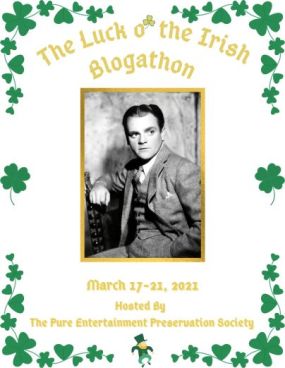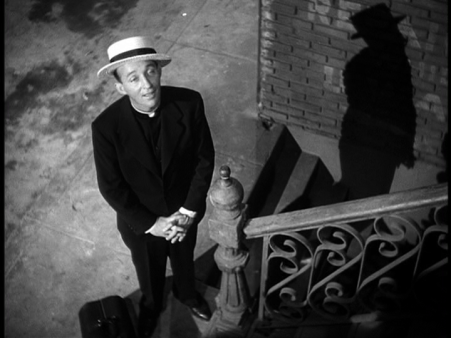
It’s a great day for the Irish…

We all know 2020 was a strange year, not only because it felt like the hits just kept on coming, but how we relate to each other was turned on its head. Certain salespeople would have us believe that being apart is no problem. Just get on Zoom or Skype. No biggie. It’s just like meeting in person. Maybe we’ll have a rousing game of Pass the Mustard.
Sorry, but no, it’s not the same, guys.

Relationships should never be underestimated. That’s what stuck out to me the last time I watched 1944’s Going My Way, probably because I’m in a time of building new relationships and renewing older ones. And since we’re here to give a nod to Ireland, the film prominently sports four people with connections to the ould sod: director Leo McCarey, Bing Crosby, Frank McHugh, and character man Barry Fitzgerald.
Father Chuck O’Malley (Bing Crosby) is the new curate at St. Dominic’s Catholic Church in New York City. The pastor, Father Fitzgibbon (Barry Fitzgerald), has been there for the past forty-five years, and he’s in such a rut that he can’t figure out why the church is in danger of foreclosure and the bishop thinks he can’t preach. The idea is that Chuck will take over for for Fitzgibbon and maybe inject some new fervor into the parish.

Chuck’s background is unconventional. He’s a prolific songwriter, can play any style of music, he worked out with the St. Louis Browns, and has a few street smarts. His way of pastoring those in need is outside the proverbial box too, such as when he gives a young runaway, Carol (Jean Heather) tips on how to put over a song, or when he turns the local gang of ruffians (including Carl “Alfalfa” Switzer and Andy Williams, by the way) into a dedicated choir.
Father Fitzgibbon is not convinced he and Chuck work well together, and when he hears the choir belt out his most hated song, “Three Blind Mice” he heads for the bishop’s office. Long story short, Father has to admit he can’t do it all alone anymore, and he and Chuck meet in the middle over a couple of shots of whiskey. He confides in Chuck that he hasn’t seen his mother in Ireland once the entire time he’s been at St. Dominic’s, but she sends him a bottle of whiskey every year.

Speaking of meeting, Chuck’s time in New York brings a couple of familiar faces back into his life. His high school friend, Tim O’Dowd (Frank McHugh) is a priest at the nearby St. Francis parish, and he’s a frequent guest at St. Dominic’s. He and Chuck like to golf, an activity Father Fitzgibbon eyes with mild disdain.
However, the Father’s not so disdainful when he meets one of Chuck’s other friends, opera singer Genevieve Linden (Risë Stevens) who works at the Met. It’s implied that Chuck and Genevieve went out once upon a time; the two meet by chance on the street one night and Genevieve has no idea Chuck became a priest. She takes this new information in stride, though, and visits the church basement when the choir practices. She understands the effect Chuck is having on the boys, since Chuck was the one who told her years ago that she could sing.

Time shows Chuck’s methods to be sound. Carol meets and marries Ted Haines, Jr. (James Brown), whose dad (Gene Lockhart) just happens to hold the mortgage on St. Dominic’s. Chuck and the new choir manage to secure funds to bring the mortgage up to date. And even Father Fitzgibbon joins Chuck and Tim on the golf course, where his fellow clergy make him look good by sneaking the ball into the hole when the Father isn’t looking.
There are so many great moments in this film. There’s a lot of gentle humor and plenty of music, including a gorgeous rendition of “Ave Maria” by Crosby, Stevens and the choir, and the highly singable “Swinging On A Star.” Only one song hits a false note; my mom told me that when the movie came out, Paramount tried really hard to make the title song, “Going My Way,” a hit but it didn’t quite catch on, probably because it is a wee bit schmaltzy.

Director Leo McCarey handled the film with a light touch, ably backed by Bing Crosby, who based the character of Father O’Malley on Father Curtis Sharp, one of his instructors at Gonzaga University. Sharp was a down-to-earth guy and a martinet for discipline, and Crosby respected him tremendously. The man never missed a trick, either. Once, when Crosby was back at his alma mater to receive an honorary degree, he sneaked into the locker room to take a swig from a flask. Sharp found both Crosby and the flask and finished off Crosby’s stash.”It wouldn’t be right to let a soldier die without a priest,” he quipped.
Not surprisingly, the major cast members wound up friends. Even though Fitzgerald was technically Crosby’s support, their scenes played so equally that Fitzgerald was nominated for both a Best Actor and a Best Supporting Actor Oscar. He won the latter, and he and Crosby would go on to make Welcome, Stranger in 1947 and Top O’ the Morning in 1949. Frank McHugh would also work with Crosby again, appearing frequently with Crosby on radio and TV.

The movie has been called corny by the more cynical critics, but I disagree, because the one of the things that has kept me coming back to it over the years is the relationships between the characters. They’re warm, they’re open, and the less than sympathetic are dealt with quietly but not inconsiderately. The local ruffians aren’t unredeemable; they just have to be reached from a different angle.
Another nice aspect is the history between Father Chuck, Father Tim, and Genevieve. Chuck and Tim croon their school song when they see each other for the first time after many years, and Chuck calls Genevieve by her former name, “Jenny Tuffel” when they meet outside the Metropolitan Opera. It’s not overstated; the three of them don’t sit around exchanging a lot of do-you-remember stories, but they don’t hesitate to remind each other of where they’ve come from and show their pride in each other’s accomplishments.

I can relate to this in a small way, having recently started going to a new church where a guy I went to high school with is the music pastor. Long story, but suffice it to say, it’s very cool. The people in this place are such a blessing and it’s all a God thing.
Getting back to Going My Way, audiences in 1944 likely appreciated the continuity of relationships as well, as most of them said goodbye to relatives and friends in the war. They must have been dreaming about renewing those friendships, if, God willing, their loved ones returned. This kind of movie would have been like a warm blanket.

The Academy certainly thought so, to the tune of ten Oscar nominations and seven wins. The film grossed seven million dollars and was one of the top hits of 1944, spawning a sequel, The Bells of St. Mary’s. No doubt the rapport of the actors and their characters went a long way toward making the film what it was.
For more of the Luck of the Irish Blogathon, please visit Tiffany and Rebekah at the Pure Entertainment Preservation Society. Thanks for hosting this, ladies–it was fun! As always, thanks for reading, all, and see you on Tuesday for Silent-ology’s Buster Keaton Blogathon…
Going My Way is available on DVD and Blu-ray from Amazon.
~Purchases made via Amazon Affiliate links found on this site help support Taking Up Room at no extra cost to you.~
Works Cited
Giddens, Gary. Bing Crosby: A Pocketful of Dreams – The Early Years 1903-1940. New York City: Little, Brown and Company, 2009.
McDannell, Colleen. Catholics In the Movies. New York City: Oxford University Press, 2008

One thought on “It’s All About People”